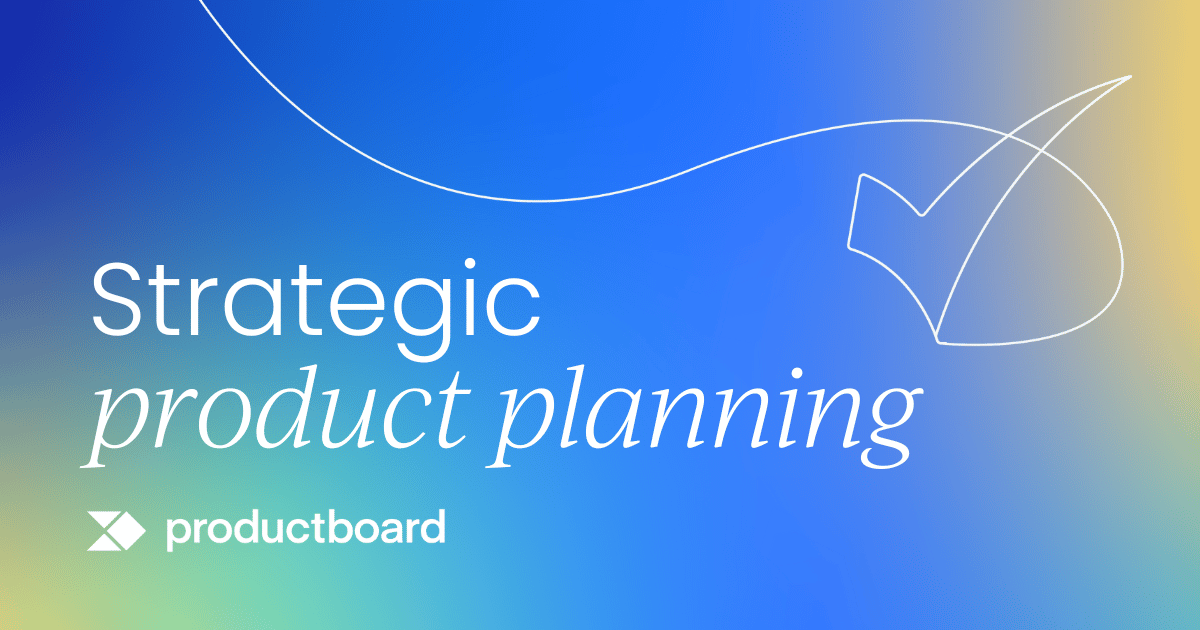It's strategic product planning season, and product teams are once again tasked with seeing the big picture while running full speed toward the end of the year.
Strategic product planning is challenging, no matter the date on the calendar. It's a major context shift to think about the vision, workflows, and more through a big-picture lens, while deep in the work you’re trying to deliver. Add on end-of-year deadlines, and the pressure builds.
And there are a lot of things that make strategy hard:
- Making sure you're building off the right data and analysis
- Not letting the loudest voice in the room sway the plan based on experience vs. evidence
- Creating a plan that's ambitious enough but still deliverable
- Understanding what's truly strategy versus what's just tactics
The list goes on.
While it may feel like a slog, in the age of AI, we're seeing time and time again that it's more important than ever. In fact, Productboard's recent survey of 100+ product leaders found that 59% say strategy is the most important skill for product managers in the AI era.
Ultimately, what strategy comes down to is doing the work, choosing your focus, and maintaining it. And that's painful.
Here's how you can get out of creating a reactive strategy this year…
4 common strategic product planning pitfalls
1. It's tactics, not strategy
This is the big one. As SVPG puts it: "So many of the companies [we] meet have a goal (like doubling revenue), and they have a product roadmap (the tactics), yet no product strategy to be found."
A goal tells you where you want to go. Tactics tell you what you're building. Strategy tells you how you're going to get there and why that's the right approach.
If your "strategy" is just a list of features on a roadmap, you don't have a strategy. You have a to-do list.
2. There's no data to back it up
"I think we should focus on enterprise customers" is an opinion. "Our analysis shows enterprise customers have 3x the LTV and 40% lower churn" is strategy.
The best product strategies are grounded in evidence – customer research, usage data, market analysis, and competitive intelligence. These aren't nice-to-haves. They're the foundation.
3. It's swayed by the loudest voice in the room
We've all been there. The exec who "just knows" what customers want. The sales leader who swears every deal is blocked by one missing feature. The engineer who's convinced the tech debt is the real problem.
Experience matters. But when the loudest voice wins without evidence, you end up with a reactive strategy that chases whoever yelled last.
4. There's a precedent
"This is how we've always done it" might be the most dangerous phrase in product management. Markets shift. User needs evolve. Competitors innovate.
Just because your strategy worked last year doesn't mean it'll work this year. Question your assumptions.
4 key components of a good product strategy
As with everything in product management, a good product strategy depends on your circumstances and environment. What your company or users need now may not be what they needed three years ago.
It all depends.
So, consider your variables while selecting your strategy. Where is your product-market fit currently? What’s your company's current growth stage, and where are you trying to go? Where is your product in the product lifecycle?
While the structure and the categories in a strategy might change, here are the core components you need:
1. Shared vision
Everyone on the team should be able to articulate where you're headed and why. If your engineers, designers, and stakeholders can't explain the vision in their own words, it's not shared – it's just written down somewhere. This isn’t just a product vision, but a company one too.
2. Pain-focused challenge
The hardest part of strategy isn't solving problems – it's identifying the right problem to solve.
You could tackle a dozen customer pain points. But which one, if solved, would actually move the needle? Which pain is so acute that customers would pay for a solution? Which challenge, if addressed, unlocks the next stage of growth?
This is where most teams go wrong. They list everything that's broken instead of zeroing in on the one challenge that matters most right now. Or worse, they pick a challenge that sounds strategic but isn't actually felt by customers.
The best strategies start with deep customer understanding. Not surveys. Not feature requests. Real conversations about what's keeping customers from achieving their goals. What workflows are broken? Where are they cobbling together workarounds? What would make them "very disappointed" if it went away?
When you anchor your strategy to a specific, validated pain point, everything else gets easier. Your roadmap has focus. Your team has clarity. Your metrics have meaning.
3. Defined audience
"Everyone" is not an audience. Neither is "SMBs" or "enterprise customers" without more detail. Who specifically are you building for? What do they care about? What keeps them up at night?
The tighter your audience definition, the sharper your strategy becomes.
4. Goal-aligned measurement
Here's the trap: teams pick metrics that are easy to measure instead of metrics that actually reveal whether the strategy is working. Revenue is a lagging indicator. So is churn. By the time these numbers move, you've already succeeded or failed – you just didn't know it yet.
You need leading indicators – metrics that predict success before it happens. When Rahul Vohra was building Superhuman, he discovered that asking "How would you feel if you could no longer use this product?" and measuring those who said "very disappointed" predicted future retention and growth before traditional metrics moved. That's goal-aligned measurement.
If your strategy is about improving onboarding, don't just measure "completion rate." Measure time-to-first-value or early activation behaviors that predict long-term retention. If your strategy is about expansion, track usage patterns that precede upsells, not just the upsells themselves.
3 key components of a good product strategy process
Here's where knowing the components isn't enough. You can understand what makes a good strategy and still end up with a reactive one.
Why? Because most teams skip the process.
They wait until the last minute, throw together a deck, and call it strategy. And that's exactly how you end up reactive.
A little tough love: you don't have time for strategy because you're not making the time.
Here's how to actually do the work:
1. Start with listening
Before you form opinions, gather inputs. Talk to customers. Review support tickets. Analyze usage data. Study what competitors are doing. And then evaluate all your sources: where do you have gaps (sources, topics, user segments)? Where is data from one source being weighted more heavily than another? What are your assumptions, and how have you challenged them intentionally?
2. Put forward a hypothesis
Based on what you've learned, what do you believe is the highest-leverage opportunity? Frame it as a hypothesis you can test: "If we focus on X, we'll achieve Y because of Z."
A good hypothesis has three parts:
- The focus: What specific area, audience, or challenge are you addressing?
- The expected outcome: What measurable result do you expect?
- The reasoning: Why do you believe this will work?
And above all, it’s specific.
A well-formed hypothesis does two things: it forces clarity about what you're betting on, and it creates accountability. If you're wrong, you'll know it and you can adjust.
This is the difference between "let's try some onboarding improvements" and "we believe that if we reduce friction in the first workflow setup, we'll increase Day 7 retention by 15 points, because our data shows early workflow completion is the strongest predictor of long-term usage."
3. Get buy-in (and build it together)
Strategy isn't something you do alone in a Google Doc and then present. The best strategies are built collaboratively with your team, your stakeholders, and your users.
Share your thoughts early. Get feedback. Iterate. When people help shape the strategy, they'll actually follow it.
The future of product strategy with AI
Here's the good news: AI is making strategy easier to do well. Not because it does the thinking for you, but because it removes a lot of the manual grunt work that used to eat up your time.
Here’s where we see AI making an impact…
Synthesizing customer feedback and data
Instead of spending hours reading through support tickets and user interviews, AI can help you identify patterns, surface themes, and quantify sentiment at scale. You can ask "What are the top three complaints from enterprise customers this quarter?" and get a data-backed answer in seconds.
There are a number of tools already that are helping companies with their voice-of-customer listening at scale, like Productboard Pulse.
Competitive analysis at your fingertips
Keeping tabs on what your competitors are doing used to mean subscribing to newsletters, browsing their websites, and hoping you didn't miss anything important. Now AI can monitor changes, summarize announcements, and help you spot trends before they become obvious.
Queryable product data
"How many users activated this feature in the last 30 days?" "What's the correlation between X and retention?" Questions that used to require SQL queries or waiting for an analyst can now be answered conversationally.
This doesn't replace human judgment. But it gives you more time to actually think instead of just gathering information.
Stop being reactive
The difference between a reactive strategy and a proactive one isn't complexity. It's commitment.
Commitment to doing the research. Commitment to making hard choices about what not to do. Commitment to saying no to the loudest voice when the data points elsewhere.
Strategy is painful because it forces you to choose. But that's exactly why it matters.
So this year, skip the reactive roadmap disguised as strategy. Do the work. Make the hard calls. And give your team something worth building toward.
The clock is ticking on annual planning, but that doesn't mean you have to rush the work. Join the Productboard Spark beta and use AI that understands your product context to move from rough ideas to delivery-ready specs faster – so you can spend less time gathering data and more time making the strategic decisions that matter.



 Follow us on LinkedIn
Follow us on LinkedIn




